The Consumer Price Index decreased by -0.1% for December as energy prices declined. Gasoline alone decreased -3.9% for the month. Inflation without food or energy prices considered increased 0.1% for the month. From a year ago overall CPI has increased 0.7%, which is very tame and the second slowest rate in 50 years. Without energy and food considered, prices have increased 2.1% for the year. CPI measures inflation, or price increases.
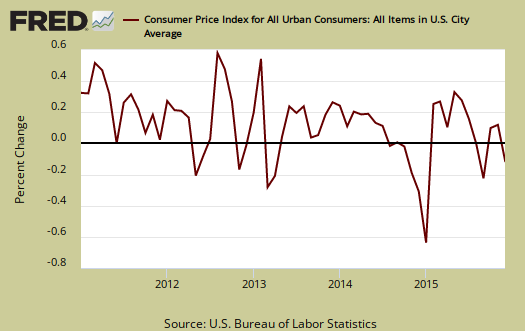
The flat yearly overall inflation is shown in the below graph, driven by low energy prices.

Core inflation, or CPI with all food and energy items removed from the index, has increased 2.1% for the last year. This is the highest annual core inflation increase since July 2012. For the past decade the annualized inflation rate has been 1.9%. What this shows is other things like homes and rents have increased dramatically and are countering out the break cheap gasoline is giving consumers.

Core CPI's monthly percentage change is graphed below. This month core inflation increased 0.1%. Within core inflation, shelter increased 0.2%. Apparel prices dropped -0.2%, used cars increased 0.1%, transportation services increased 0.2% and airfare dropped -1.1% for the month. Auto insurance increased 0.5% for the month and increased 1.1% the previous.
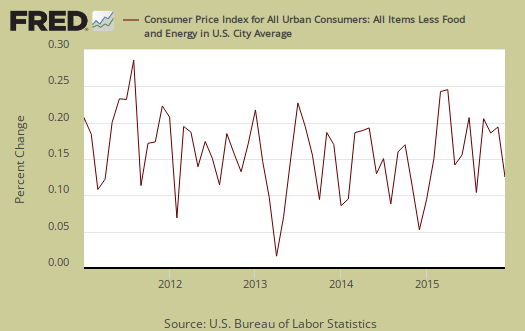
The energy index is down -12.6% from a year ago. The BLS separates out all energy costs and puts them together into one index. For the year, gasoline has declined -19.7%, while Fuel oil has dropped -31.4%. Fuel oil dropped -7.8 % for the month alone. Graphed below is the overall CPI energy index.
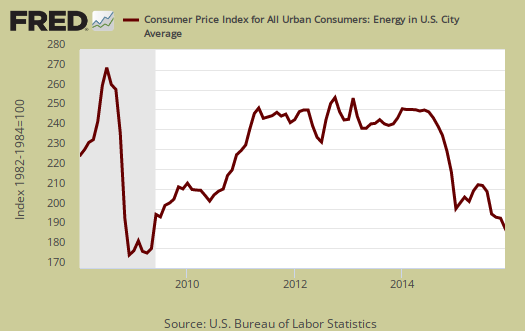
Graphed below is the CPI gasoline index only as gas-guzzlers rejoice.
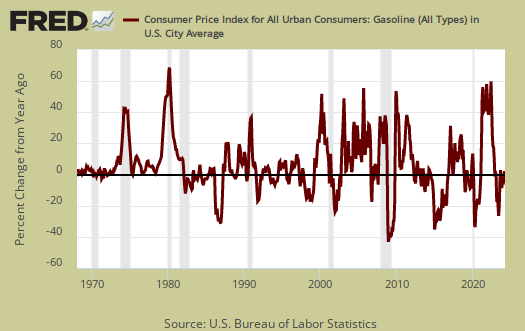
Core inflation's components include shelter, transportation, medical care and anything that is not food or energy. The shelter index is comprised of rent, the equivalent cost of owning a home, hotels and motels. Shelter increased 0.2% and is up 3.2% for the year. Rent just keeps increasing and this month by 0.2% and is up 3.7% for the year. Graphed below is the rent price index.

Food prices decreased -0.2% for the month. Food and beverages have now increased just 0.8% from a year ago. Groceries, (called food at home by BLS), plunged -0.5% for the month, and are down -0.4% for the year. The reason was the meats, poultry, fish, and eggs index declined by -1.4%. This is the largest decrease since August 1979. The beef index
fell by -2.4% and eggs dropped by -3.4%. Eating out, or food away from home increased 0.1% for the month and is up 2.6% for the year.
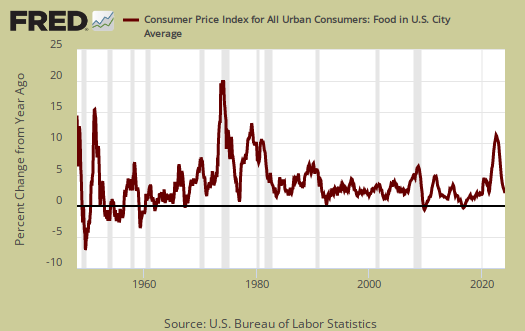
Graphed below are groceries, otherwise known as the food at home index.
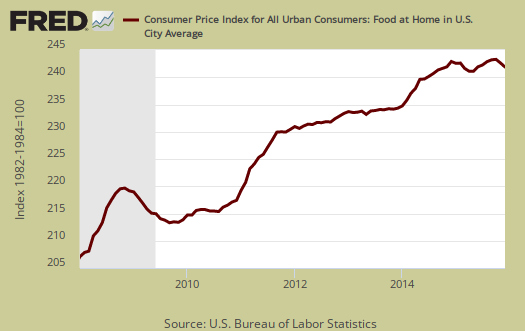
Medical care services were up 0.1% for the month and have increased 2.9% for the year. Graphed below is the overall medical care index, which increased 0.1% for the month and is up 2.6% from a year ago.

Below is a graph of the medical commodities index, which is mostly prescription drug prices. Medical commodities decreased by -0.1% for the month and is up 1.5% for the past year.

Real hourly earnings increased by 0.1% for all employees. Real means wages adjusted for inflation and since CPI decreased by -0.1% and wages had no change. For the year real hourly earnings have increased 1.8%, clearly not staying ahead of the inflation game. The average real hourly wage is now $10.61. Weekly real earnings increased 0.1% for the month. Real weekly earnings now stand at $366.11. Hours worked did not change for the month. There is a separate category for production and nonsupervisory employees and their real hourly earnings increased 0.3%.
Overall housing is the real cost for most people and wages are not keeping up with soaring costs.
CPI details
The DOL/BLS does take yearly surveys on where the money goes in the monthly budget, but as one can see, food and energy are significant amounts of the monthly finances. Run away costs in these two areas can break the bank, so can food. Additionally CPI uses substitution, so if flour goes through the roof, somehow we're all just fine with oats and prices didn't really overall increase much. Here is the BLS CPI site, where one can find much more details, information on calculation methods and error margins.
Other CPI report overviews, unrevised, although most graphs are updated, are here. If you're wondering why the graphs display different figures from the text, the graphs calculate percentages from the index and do not round. The actual data from the BLS report does round to one decimal place. In other words, 0.05% is rounded to 0.1%.

impact of lower consumer prices on 4th quarter GDP
with this release, we are now able to estimate the economic impact of last week's December retail sales report...for the most accurate estimate, and the way the BEA will figure 4th quarter GDP next week, we would have to take each type of retail sales and adjust it with the appropriate change in price to determine real sales; for instance, December's clothing sales, which fell by 0.9%, should be adjusted with the price index for apparel, which was down by 0.2%, to show us that real retail sales of clothing were down just 0.7% in December...then, to get GDP relevant changes, we'd have to compare those real clothing sales in the months of October, November and December to real sales in the 3rd quarter months of July, August and September, and then repeat that for each other type of retailer, obviously quite a tedious chore...the short cut we usually use for a ballpark estimate is to apply the composite price index of all commodities less food and energy commodities, which was down 0.1%, to retail sales less grocery, gas station, and restaurant sales, which account for nearly 70% of aggregate retail sales....those sales were almost down 0.1% in December, and since their price index was also down 0.1%, real retail sales ex food and energy were up but statistically unchanged...in the food and energy components, grocery stores sales were down 0.1% while prices for food at home were down 0.5%, meaning real food sales rose by 0.4% in December...next, sales at bars and restaurants were up 0.8% in dollars, but those dollars bought 0.2% less, so real sales of food away from home was up 0.6%...and while gas station sales were down 1.1%, gasoline prices were down 3.9%, suggesting a solid real increase in gasoline sold as well...weighing the food and energy components at one third of total retail sales suggests that real retail sales were up on the order of 0.2% in December, following a an increase of 0.5% in real sales in November and a 0.2% increase in October...together, these increases suggest a decent contribution from personal consumption of goods, which accounts for 23% of GDP, when the advance 4th quarter GDP report is released on January 29th...
rjs
be there or be square
I haven't been calculating any GDP component but it seems inventories have been contracting, especially in manufacturing so I am not expecting a good number, although PCE should be about the same as Q3, but this is with my thumb in the air estimate.
PCE services
PCE goods look good once adjusted for inflation, but PCE services doesn't get a similar boost...i think they were unchanged in November, mostly on lower utility usage, which i expect will be even worse in December when over 30 states saw all time high temperatures...the utility index in industrial production is a good proxy for what will happen to the household services in December PCE...
so GDP looks like weak PCE vs slumping inventories, with weakness elsewhere else nearly a wash...i think JP Morgan Chase now sees 4th quarter growth at 0.1%
rjs